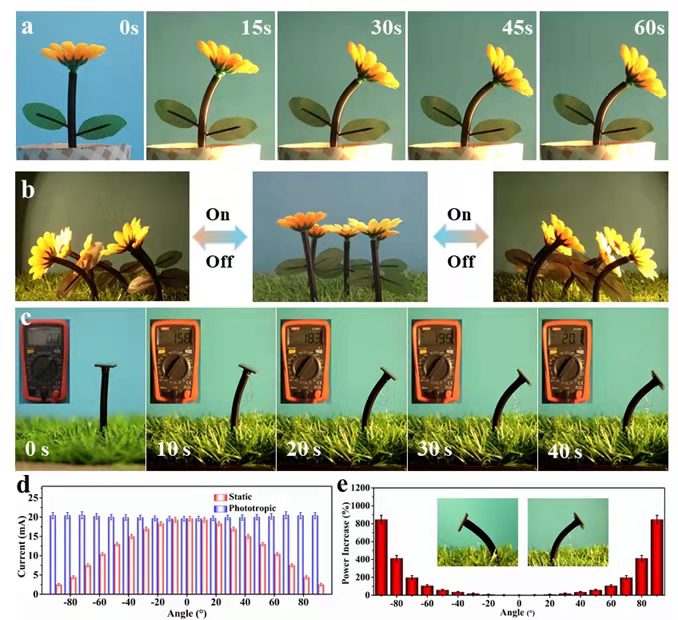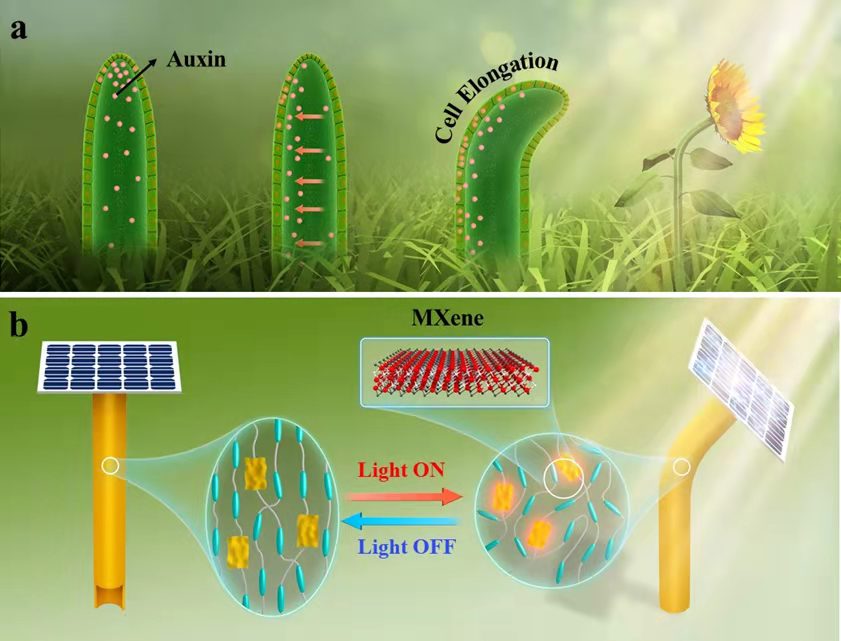Researchers from Tianjin University have developed a bioinspired phototropic MXene-reinforced soft tubular actuator that can boost the development of somatosensory soft robotics and adaptive optoelectronics.
Video: An array ofbiomimeticphototropic sunflowers adapt to a changing light source
This sunflower-like artificial intelligent material has long interested researchers and engineers because of its high light-tracking accuracy, quick sensing, continuous tracking, and adaptive interaction with the incident light in all zenithal and azimuthal angles of 3D space thanks to the distinct hollow structure, radially symmetrical shape, and built-in self-shadowing photo-thermo-mechanical feedback like a hollow stem of plants. But today’s artificial phototropic systems suffer from at least one of the following limitations: high actuation power, weak mechanical properties, and/or inadequate light-tracking capability in 3D space.

Biomimeticsunflowers and adaptive photovoltaic systems based on MXene-LCE soft tubular actuators
Now, researchers at the School of Materials Science and Engineering of Tianjin University led by Professor Feng Wei have designed and prepared a bioinspired phototropic MXene-reinforced liquid crystal elastomers (LCEs) soft tubular actuator with omnidirectional self-orienting capability, which was judiciously fabricated through in situ free-radical photopolymerization of MXene nanomonomer into crosslinked main-chain LCE polymer networks. LCEs that combine polymer elasticity and mesogenic anisotropy are known to exhibit multiple advantageous features, including multi-stimuli responsiveness, muscle-like mechanical property, large and reversible actuation as well as programmable shape-morphing performance, which have a wide range of applications beyond materials with biomimetic intelligence, artificial muscle and adaptive actuation systems. In addition, the polymerizable MXene nanomonomer endows the LCE soft tubular actuator with fast photothermal actuation and enhanced mechanical properties. The study could thereby not only provide new insights into the soft-matter-based self-regulatory intelligence via built-in feedback control, but also open up new avenues toward the development of adaptive optoelectronics, self-regulating optics and photonics, advanced solar harvesters, as well as intelligent soft robotics and somatosensory soft machines.

Schematic illustrationof the phototropic mechanism andadaptive photovoltaics
Such achievement of this study is also credited to the combination of the gift of nature and cutting-edge technology. “Nature is a source of various technical ideas, engineering principles and major inventions for mankind. The unique phototropism of sunflowers has been a constant inspiration throughout what we've been developing novel materials and technology with biomimetic intelligence,” Professor Feng said.
Many plants in nature are capable of self-adapting to the constant changes of the surrounding sunlight and maximizing solar energy harvesting by self-orienting their leaves or flowers. Access to a larger area of light illuminations is therefore more conducive to photosynthesis and enables plants to grow better. Phototropism commonly observed in many plants (e.g., sunflower—as a typical representative) is a promising adaptive actuation system with self-regulatory capability.
“As a proof-of-concept demonstration, we prepared a ‘biomimetic phototropic sunflower’ that can adapt to a changing unconcentrated light source,” Professor Feng added.
The research result was published on the journal Advanced Functional Materials.
By Zou Yu
Editors: School of Materials Science and Engineering, Sun Xiaofang






